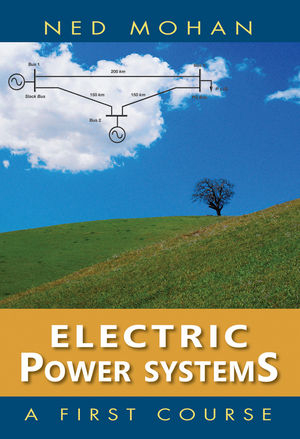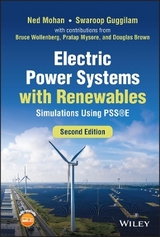
Electric Power Systems
John Wiley & Sons Inc (Verlag)
978-1-118-07479-4 (ISBN)
- Titel erscheint in neuer Auflage
- Artikel merken
This book is part of a three-book series for the sequence of electric power electives taught in most large universities' Electrical Engineering departments. Advances in hybrid-electric cars and alternative energy systems, coupled with the severe environmental problems associated with hydrocarbon-based fuels, are driving renewed interest in the electric energy systems (EES) curriculum at the Undergraduate level.
Ned Mohan has been a leader in EES education and research for decades, as author of the best-selling text/reference Power Electronics with Wiley and a series of textbooks self-published under the MNPERE imprint. Mohan leads a consortium of 80+ universities working to revitalize electric power engineering education. These texts are based on the integrated curriculum developed over nearly 15 years of research in education in this field.
Since the subject of Electric Power Systems encompasses a large and complex set of topics, a unique aspect of this book is a balanced approach in presenting as many topics as possible on a fundamental basis for a single-semester course. These topics include how electricity is generated and how it is used by various loads, and the network and various apparatus in between. Students see the big picture and learn the fundamentals at the same time. Sequencing of these topics is considered carefully to avoid repetition and to retain student and reader interest. However, instructors can rearrange the order for the most part, based on their own experiences and preferences.
Ned Mohan is the Oscar A. Schott Professor of Power Electronics in the Department of Electrical Engineering at the University of Minnesota, where he has been teaching for 33 years. He has written five textbooks; one of them has been translated into several languages. He has 13 patents and has written over 200 technical articles. He is actively involved in the area of renewable energy and is working on the next generation of wind generators and storage. He received the Distinguished Teaching Award by the Institute of Technology at the University of Minnesota. He is a Morse-Alumni Distinguished Teaching Professor and is a member of the Academy of Distinguished Teachers at the University of Minnesota. He received the Outstanding Educator Award from the Power Engineering Society of the IEEE in 2008. He is a Fellow of the IEEE.
PREFACE xi CHAPTER 1 POWER SYSTEMS: A CHANGING LANDSCAPE 1
1.1 Nature of Power Systems 1
1.2 Changing Landscape of Power Systems and Utility Deregulation 2
1.3 Topics in Power Systems 3
References 4
Problems 5
CHAPTER 2 REVIEW OF BASIC ELECTRIC CIRCUITS AND ELECTROMAGNETIC CONCEPTS 6
2.1 Introduction [1] 6
2.2 Phasor Representation in Sinusoidal Steady State 6
2.3 Power, Reactive Power, and Power Factor 9
2.4 Three-Phase Circuits 15
2.5 Real and Reactive Power Transfer Between AC Systems 21
2.6 Apparatus Ratings, Base Values, and Per-Unit Quantities 22
2.7 Energy Efficiencies of Power System Apparatus 24
2.8 Electromagnetic Concepts 24
Reference 33
Problems 33
Appendix 2A 35
CHAPTER 3 ELECTRIC ENERGY AND THE ENVIRONMENT 39
3.1 Introduction 39
3.2 Choices and Consequences 39
3.3 Hydro Power 40
3.4 Fossil FuelBased Power Plants 41
3.5 Nuclear Power 43
3.6 Renewable Energy 45
3.7 Distributed Generation (DG) 52
3.8 Environmental Consequences and Remedial Actions 52
3.9 Resource Planning 53
References 55
Problems 55
CHAPTER 4 AC TRANSMISSION LINES AND UNDERGROUND CABLES 57
4.1 Need for Transmission Lines and Cables 57
4.2 Overhead AC Transmission Lines 57
4.3 Transposition of Transmission Line Phases 59
4.4 Transmission Lines Parameters 59
4.5 Distributed-Parameter Representation of Transmission Lines in Sinusoidal Steady State 66
4.6 Surge Impedance Zc and the Surge Impedance Loading (SII) 68
4.7 Lumped Transmission Line Models in Steady State 70
4.8 Cables [8] 72
References 73
Problems 74
Appendix 4A Long Transmission Lines 75
CHAPTER 5 POWER FLOW IN POWER SYSTEM NETWORKS 78
5.1 Introduction 78
5.2 Description of the Power System 79
5.3 Example Power System 79
5.4 Building the Admittance Matrix 80
5.5 Basic Power Flow Equations 82
5.6 Newton-Raphson Procedure 83
5.7 Solution of Power Flow Equations Using N-R Method 85
5.8 Fast Decoupled N-R Method for Power Flow 89
5.9 Sensitivity Analysis 90
5.10 Reaching the Bus Var Limit 90
5.11 Synchronized Phasor Measurements, Phasor Measurement Units (PMUs), and Wide-Area Measurement Systems 91
References 91
Problems 91
Appendix 5A Gauss-Seidel Procedure for Power Flow Calculations 92
CHAPTER 6 TRANSFORMERS IN POWER SYSTEMS 94
6.1 Introduction 94
6.2 Basic Principles of Transformer Operation 94
6.3 Simplified Transformer Model 99
6.4 Per-Unit Representation 101
6.5 Transformer Efficiencies and Leakage Reactances 103
6.6 Regulation in Transformers 104
6.7 Auto-Transformers 104
6.8 Phase-Shift Introduced by Transformers 106
6.9 Three-Winding Transformers 107
6.10 Three-Phase Transformers 108
6.11 Representing Transformers with Off-Nominal Turns Ratios, Taps, and Phase-Shift 108
References 110
Problems 110
CHAPTER 7 HIGH VOLTAGE DC (HVDC) TRANSMISSION SYSTEMS 113
7.1 Introduction 113
7.2 Power Semiconductor Devices and Their Capabilities 113
7.3 HVDC Transmission Systems 114
7.4 Current-Link HVDC Systems 115
7.5 Voltage-Link HVDC Systems 125
References 129
Problems 130
CHAPTER 8 DISTRIBUTION SYSTEM, LOADS, AND POWER QUALITY 132
8.1 Introduction 132
8.2 Distribution Systems 132
8.3 Power System Loads 133
8.4 Power Quality Considerations 137
8.5 Load Management [6,7] and Smart Grid 148
8.6 Price of Electricity [3] 149
References 149
Problems 149
CHAPTER 9 SYNCHRONOUS GENERATORS 151
9.1 Introduction 151
9.2 Structure 152
9.3 Induced EMF in the Stator Windings 154
9.4 Power Output, Stability, and the Loss of Synchronism 159
9.5 Field Excitation Control to Adjust Reactive Power 160
9.6 Field Exciters for Automatic Voltage Regulation (AVR) 162
9.7 Synchronous, Transient, and Subtransient Reactances 162
References 164
Problems 165
CHAPTER 10 VOLTAGE REGULATION AND STABILITY IN POWER SYSTEMS 166
10.1 Introduction 166
10.2 Radial System as an Example 166
10.3 Voltage Collapse 169
10.4 Prevention of Voltage Instability 170
References 176
Problems 176
CHAPTER 11 TRANSIENT AND DYNAMIC STABILITY OF POWER SYSTEMS 178
11.1 Introduction 178
11.2 Principle of Transient Stability 178
11.3 Transient Stability Evaluation in Large Systems 186
11.4 Dynamic Stability 187
References 188
Problems 188
Appendix 11A Inertia, Torque and Acceleration in Rotating Systems 188
CHAPTER 12 CONTROL OF INTERCONNECTED POWER SYSTEM AND ECONOMIC DISPATCH 192
12.1 Control Objectives 192
12.2 Voltage Control by Controlling Excitation and the Reactive Power 193
12.3 Automatic Generation Control (AGC) 194
12.4 Economic Dispatch and Optimum Power Flow 201
References 206
Problems 206
CHAPTER 13 TRANSMISSION LINE FAULTS, RELAYING, AND CIRCUIT BREAKERS 208
13.1 Causes of Transmission Line Faults 208
13.2 Symmetrical Components for Fault Analysis 209
13.3 Types of Faults 211
13.4 System Impedances for Fault Calculations 215
13.5 Calculation of Fault Currents in Large Networks 218
13.6 Protection against Short-Circuit Faults 219
References 227
Problems 227
CHAPTER 14 TRANSIENT OVERVOLTAGES, SURGE PROTECTION, AND INSULATION COORDINATION 229
14.1 Introduction 229
14.2 Causes of Overvoltages 229
14.3 Transmission Line Characteristics and Representation 230
14.4 Insulation to Withstand Overvoltages 233
14.5 Surge Arresters and Insulation Coordination 234
References 235
Problems 235
| Verlagsort | New York |
|---|---|
| Sprache | englisch |
| Maße | 183 x 252 mm |
| Gewicht | 544 g |
| Themenwelt | Technik ► Elektrotechnik / Energietechnik |
| ISBN-10 | 1-118-07479-3 / 1118074793 |
| ISBN-13 | 978-1-118-07479-4 / 9781118074794 |
| Zustand | Neuware |
| Haben Sie eine Frage zum Produkt? |
aus dem Bereich



